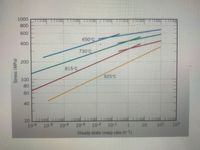
Elements Of Electromagnetics
7th Edition
ISBN: 9780190698614
Author: Sadiku, Matthew N. O.
Publisher: Oxford University Press
expand_more
expand_more
format_list_bulleted
Concept explainers
Question
Calculate the activation energy in j/mol for the creep of an alloy having the steady state creep behavior shown below. Use the data taken at stress level 300MPa and the temperature of 650C and 730C. Assume the stress component n is independent of the temperature.

Transcribed Image Text:This graph illustrates the relationship between stress and steady-state creep rate for a material at different temperatures. The x-axis represents the steady-state creep rate measured in hours to the power of negative one (h⁻¹), ranging from \(10^{-6}\) to \(10^3\). The y-axis indicates stress in megapascals (MPa), ranging from 20 MPa to 1000 MPa.
The graph features four lines, each corresponding to a different temperature:
- **925°C (Orange Line):** Shows a lower stress level for a given creep rate compared to the other temperatures, indicating that the material creeps more easily at this temperature.
- **815°C (Red Line):** Indicates higher stress levels than at 925°C for the same creep rates.
- **730°C (Green Line):** Requires higher stress for a similar creep rate, suggesting reduced creep compared to lower temperatures.
- **650°C (Blue Line):** Exhibits the highest stress levels for the same creep rates, showing the least propensity to creep.
The general trend observed is that as temperature increases, the material can sustain a given creep rate at lower stress levels. This graph is useful for understanding how temperature influences the creep behavior of materials in engineering applications.
Expert Solution
This question has been solved!
Explore an expertly crafted, step-by-step solution for a thorough understanding of key concepts.
Step by stepSolved in 2 steps with 2 images

Knowledge Booster
Learn more about
Need a deep-dive on the concept behind this application? Look no further. Learn more about this topic, mechanical-engineering and related others by exploring similar questions and additional content below.Similar questions
- The yield strength for an alloy that has an average grain diameter of 5.9 x 10-2 mm is 148 MPa. At a grain diameter of 7.8 × 10-³ mm, the yield strength increases to 233 MPa. At what grain diameter, in mm, will the yield strength be 247 MPa? d = i mmarrow_forwardan alloy with an avg grain diameter of 0.053 mm is l16 MPa. When the grain diameter is 0.008Amm, the yeild strength goesupto 231 MPa.lf the yeild strength is 207MPA, what would the grain diameter be?arrow_forwardThe yield strength for an alloy that has an average grain diameter of 5.2 x 102 mm is 110 MPa. At a grain diameter of 6.3 x 103 mm, the yield strength increases to 251 MPa. At what grain diameter, in mm, will the yield strength be 222 MPa? d = mmarrow_forward
- In a laboratory creep experiment at 1273K, a steady-state creep rate of 5 ××10-1 %, per hour is obtained in a metal alloy. The creep mechanism for this alloy is known to be dislocation climb with an activation energy of 200 kJ>mol. Predict the service temperature in (°C) for a creep rate of 8.68 ×10-5 %, per hour. (Assume that the laboratory experiment duplicated the service stress.)arrow_forwardUsing the equation Kica, plot the fracture stress (MPa) for aluminum alloy 7075-T651 versus surface crack size a (mm) for a values from 0.2 mm to 2.0 mm. What is the minimum size surface crack that will cause catastrophic failure?arrow_forwardThe yield strength for an alloy that has an average grain diameter of 4.6 x 10-2 mm is 105 MPa. At a grain diameter of 7.7 × 103 mm, the yield strength increases to 248 MPa. At what grain diameter, in mm, will the yield strength be 234 MPa? d = i mmarrow_forward
- Calculate the activation energy in J/mol for creep for an alloy having the steady state creep behavior shown in the figure. Use the data taken at stress level of 300MPa and temperature of 650C and 730C. Assume that the stress component n is independent of the temperature.arrow_forwardSuppose that a wing component on an aircraft is fabri- cated from an aluminum alloy that has a plane-strain fracture toughness of 26.0 MPa Vm (23.7 ksi Vin.). It has been determined that fracture results at a stress of 112 MPa (16,240 psi) when the maximum internal crack length is 8.6 mm (0.34 in.). For this same component and alloy, compute the stress level at which fracture will occur for a critical internal crack length of 6.0 mm (0.24 in.).arrow_forward
arrow_back_ios
arrow_forward_ios
Recommended textbooks for you
 Elements Of ElectromagneticsMechanical EngineeringISBN:9780190698614Author:Sadiku, Matthew N. O.Publisher:Oxford University Press
Elements Of ElectromagneticsMechanical EngineeringISBN:9780190698614Author:Sadiku, Matthew N. O.Publisher:Oxford University Press Mechanics of Materials (10th Edition)Mechanical EngineeringISBN:9780134319650Author:Russell C. HibbelerPublisher:PEARSON
Mechanics of Materials (10th Edition)Mechanical EngineeringISBN:9780134319650Author:Russell C. HibbelerPublisher:PEARSON Thermodynamics: An Engineering ApproachMechanical EngineeringISBN:9781259822674Author:Yunus A. Cengel Dr., Michael A. BolesPublisher:McGraw-Hill Education
Thermodynamics: An Engineering ApproachMechanical EngineeringISBN:9781259822674Author:Yunus A. Cengel Dr., Michael A. BolesPublisher:McGraw-Hill Education Control Systems EngineeringMechanical EngineeringISBN:9781118170519Author:Norman S. NisePublisher:WILEY
Control Systems EngineeringMechanical EngineeringISBN:9781118170519Author:Norman S. NisePublisher:WILEY Mechanics of Materials (MindTap Course List)Mechanical EngineeringISBN:9781337093347Author:Barry J. Goodno, James M. GerePublisher:Cengage Learning
Mechanics of Materials (MindTap Course List)Mechanical EngineeringISBN:9781337093347Author:Barry J. Goodno, James M. GerePublisher:Cengage Learning Engineering Mechanics: StaticsMechanical EngineeringISBN:9781118807330Author:James L. Meriam, L. G. Kraige, J. N. BoltonPublisher:WILEY
Engineering Mechanics: StaticsMechanical EngineeringISBN:9781118807330Author:James L. Meriam, L. G. Kraige, J. N. BoltonPublisher:WILEY

Elements Of Electromagnetics
Mechanical Engineering
ISBN:9780190698614
Author:Sadiku, Matthew N. O.
Publisher:Oxford University Press

Mechanics of Materials (10th Edition)
Mechanical Engineering
ISBN:9780134319650
Author:Russell C. Hibbeler
Publisher:PEARSON

Thermodynamics: An Engineering Approach
Mechanical Engineering
ISBN:9781259822674
Author:Yunus A. Cengel Dr., Michael A. Boles
Publisher:McGraw-Hill Education

Control Systems Engineering
Mechanical Engineering
ISBN:9781118170519
Author:Norman S. Nise
Publisher:WILEY

Mechanics of Materials (MindTap Course List)
Mechanical Engineering
ISBN:9781337093347
Author:Barry J. Goodno, James M. Gere
Publisher:Cengage Learning

Engineering Mechanics: Statics
Mechanical Engineering
ISBN:9781118807330
Author:James L. Meriam, L. G. Kraige, J. N. Bolton
Publisher:WILEY